Raiders of the Lost Amphitheatre
Ian Blair
Judging by the photos, the summer of 1987 was a very good one!
At that time, I was working on the Guildhall Art Gallery site (GAG87) supervised by Nick Bateman: the remains of the Roman amphitheatre yet to be found.
The site was essentially divided into two halves, that to the north delineated by the substantial remains of the 15th century Guildhall Chapel, comprising the foundations of all four outer walls and the north and south arcades, which survived up to 3m (10ft) high. To the south of the Chapel the excavation area was constrained by the existing footprint of massive 19th century brick foundations, that effectively compartmentalised the excavation areas into a series of adjoining self-contained square bays.
It is interesting and indeed sobering to look back at the summary for the Guildhall Art Gallery published in the London Archaeologist round-up of sites excavated in 1987, which illustrates the initial on-going interpretation of Roman features still being excavated in January 1988:
‘In the early to mid-Roman period, substantial cellared masonry buildings were constructed by cutting into the gently-sloping hillside to the W of one of the Walbrook tributaries. The site appears to lie at the junction of two different sets of topographic constraints since the buildings in the N were aligned NW-SE and those in the S were aligned E-W. A sequence of internal and external (?yard) surfaces were recorded.
In the SW of the site the earliest Roman feature is a substantial timber structure with a plank floor. It appears to overlie a tributary of the Walbrook. Only the edge of the structure has been observed, but it is hoped that the remainder will become available for controlled excavation after the developers' reduction of the rest of the site.’
Though the remains of the Roman amphitheatre were already in plain sight, they were not formally identified as such until a month later in February 1988, with the elements outlined above subsequently proving to be part of the curving north wall of the arena, part of the southern entrance way wall, and the central east-west timber drain running through the entrance way into the arena.
The full story of the discovery of the amphitheatre and its eventual identification as such is comprehensively described in Nick Bateman’s 1990 article in the London Archaeologist: ‘The discovery of Londinium’s amphitheatre: excavations at the Old Art Gallery site 1987-88 and 1990’, which is reproduced at the end of this post.
Returning to my opening comment. This post was prompted by Nick sending me a series of photos of the archaeologists, taken in the early months of the excavation, who eventually (if initially unknowingly!) discovered the Roman amphitheatre. We are all seen in high-spirits taking a break from the hot summer weather, no spray-tans required in those days, having a well-earned drink or two to cool down. Clearly there was no formal dress code and fashion was relatively relaxed, with Personal Protective Equipment (PPE) little in evidence (like the clothes it seems!).
The strange open-weave baseball type cardboard hats that we are all wearing, sporting the British Telecom logo of the time, I assume were freebies garnered from some function or other held in the Guildhall Yard. It is doubtful however that they would have been robust enough to offer much protection from a falling rock in the trenches, but fortunately they were never put to the test!
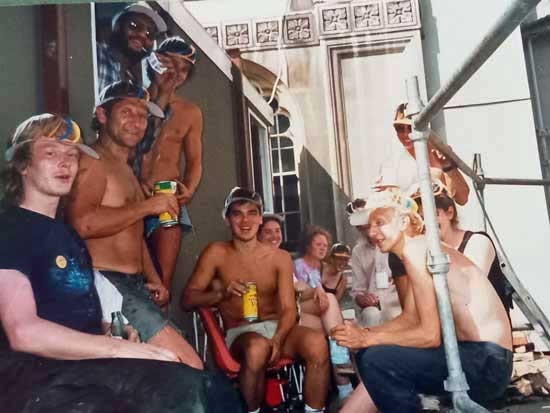 ‘Party on!’ The Guildhall Art Gallery archaeologists in happy relaxed mood during the hot summer of 1987. Clockwise from left: Paul Travis, Prince Chitwood, Claude ?, Ian Blair, Tim Ellis, Margaret Westmoreland, Hester White, Marietta Ryan, Christopher Sparey-Green, Nick Bateman, Angela Pertusini, Nick Churchill
‘Party on!’ The Guildhall Art Gallery archaeologists in happy relaxed mood during the hot summer of 1987. Clockwise from left: Paul Travis, Prince Chitwood, Claude ?, Ian Blair, Tim Ellis, Margaret Westmoreland, Hester White, Marietta Ryan, Christopher Sparey-Green, Nick Bateman, Angela Pertusini, Nick Churchill
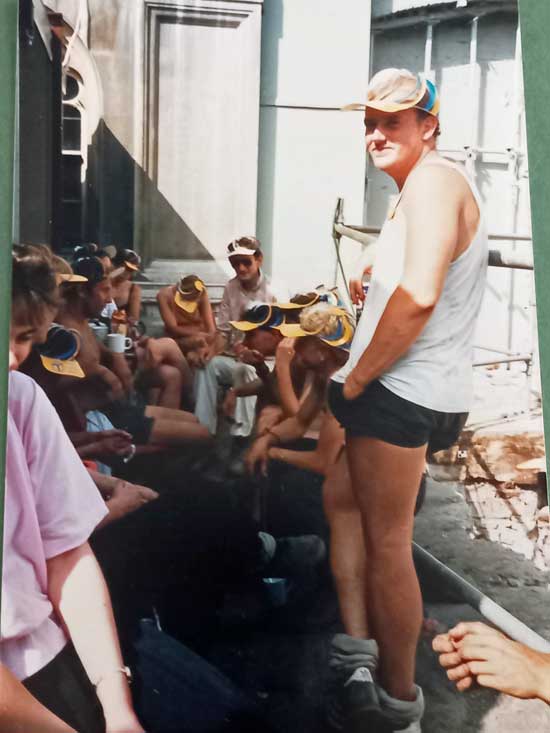 Sometime later: a more subdued soporific mood pervades (possibly alcohol induced!), the team now joined by Josephine Brown and Julian Hill
Sometime later: a more subdued soporific mood pervades (possibly alcohol induced!), the team now joined by Josephine Brown and Julian Hill
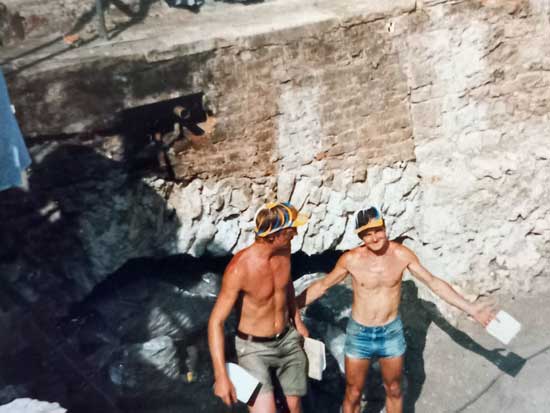 Nick Bateman and Andrew Westman in the remains of the Guildhall Chapel on the north side of the (GAG87) excavation
Nick Bateman and Andrew Westman in the remains of the Guildhall Chapel on the north side of the (GAG87) excavation
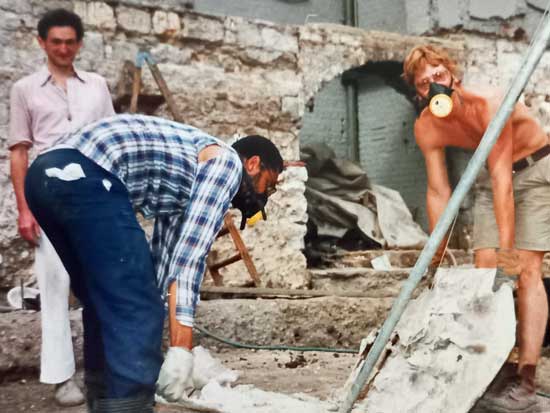 Nick Bateman and Claude moving a heavy lead coffin from the 15th century Guildhall Chapel with Christopher Sparey-Green offering moral support from a safe distance
Nick Bateman and Claude moving a heavy lead coffin from the 15th century Guildhall Chapel with Christopher Sparey-Green offering moral support from a safe distance
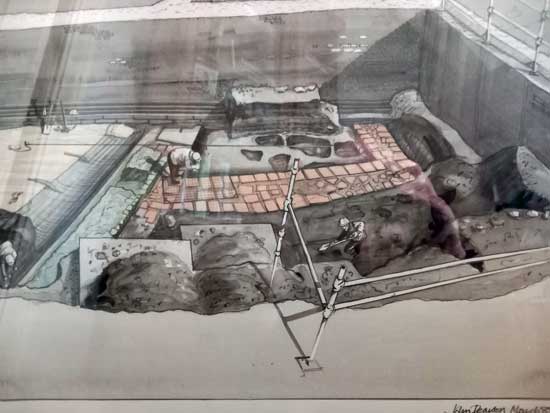 Fine drawing by John Pearson undertaken in March 1988 some four weeks after the news broke that the Roman amphitheatre had been discovered at the Guildhall. It shows the now much-expanded south side of the excavation, the southern antechamber, curving arena wall and flanking perimeter drain. The figure who is shovelling away in the foreground is thought to be Gina Porter, who ironically was rarely captured in photographs!
Fine drawing by John Pearson undertaken in March 1988 some four weeks after the news broke that the Roman amphitheatre had been discovered at the Guildhall. It shows the now much-expanded south side of the excavation, the southern antechamber, curving arena wall and flanking perimeter drain. The figure who is shovelling away in the foreground is thought to be Gina Porter, who ironically was rarely captured in photographs!

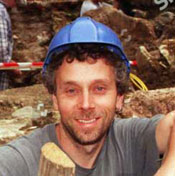

Comments powered by CComment